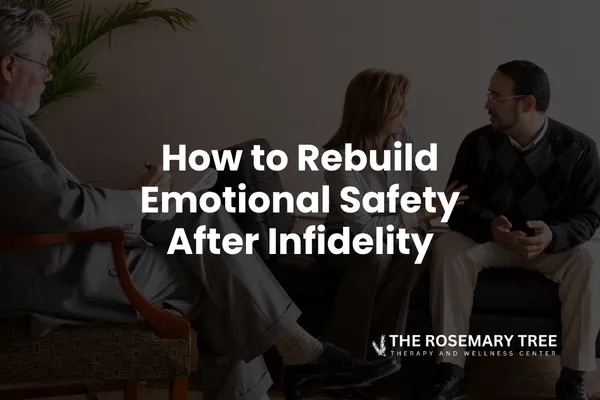
How to Rebuild Emotional Safety After Infidelity
When Trust Is Shaken
After infidelity, emotions feel unpredictable. One moment you want to repair the relationship, and the next you want to run away. The betrayed partner often feels unsafe, while the one who caused harm may feel desperate to make things right but unsure how.
Both people are hurting. Both are trying to find their footing again. Rebuilding emotional safety means learning how to approach each other with honesty, calm, and care, even when the pain feels unbearable.
Why Emotional Safety Matters More Than Words
Apologies and promises are important, but without emotional safety, they cannot take root. Emotional safety allows both partners to express what they feel without fear of being attacked, dismissed, or judged.
In the early stages of recovery, couples often try to “move on” too quickly, hoping that time or forgiveness will fix the problem. But healing begins not with time, but with safety. When both partners feel secure enough to speak the truth, genuine trust can start to grow again.
What Emotional Safety Looks Like in Practice
Emotional safety is not about perfection. It is about creating consistent patterns that build calm and trust over time. Here are key elements that help restore it:
Transparency and Honesty
Secrets fuel fear. Honesty, even when it is difficult, helps the betrayed partner begin to believe again that what is said can be trusted.Consistency
Change is proven through repetition. Small, reliable actions—showing up on time, following through, communicating openly—build a foundation stronger than any apology.Active Listening
Listening without interrupting or defending shows that you value your partner’s experience, even when it hurts to hear.Calm Communication
Arguments cannot rebuild safety. Pausing to breathe, grounding the body, and speaking gently help both partners stay emotionally present.Validation
You do not have to agree to validate. Saying “I understand why you feel that way” or “That makes sense” can begin to restore connection.
When You Keep Getting Triggered
For the betrayed partner, sudden waves of anger, anxiety, or sadness are normal. A small reminder can bring everything rushing back. For the partner who caused the pain, these moments can feel confusing or discouraging.
This is part of the trauma response. The goal is not to stop triggers but to respond to them differently. During therapy, couples learn grounding techniques to calm the nervous system so both partners can remain present and supportive instead of reactive.
A few simple steps include:
Taking a slow, deep breath before responding
Pausing physical touch if it feels overwhelming
Checking in with gentle questions like “Do you need space or comfort right now?”
Practicing mindfulness together through short, calm moments of eye contact or hand-holding when both feel ready
Accountability Without Control
Safety does not come from tracking, checking, or controlling. It comes from accountability that is freely offered.
For the partner rebuilding trust, accountability looks like:
Voluntarily sharing information or updates
Keeping communication consistent
Following through on commitments without being asked
Owning mistakes immediately and calmly
For the betrayed partner, it means setting clear boundaries that protect your wellbeing while allowing space for honesty and repair.
How Therapy Intensives Help Couples Rebuild Safety
Weekly sessions can provide valuable insight, but for many couples in crisis, the pace feels too slow. When emotions are raw and mistrust runs deep, an hour often ends just as the real work begins.
Our Accelerated Deep-Work Therapy Intensives offer a focused environment where couples can slow down, process emotions safely, and begin creating new patterns of communication.
During an intensive, you and your partner will:
Understand how trauma impacts both people after infidelity
Learn tools for grounding and emotional regulation
Practice safe, structured dialogue guided by licensed clinicians
Develop a realistic plan to maintain emotional safety after the intensive ends
These extended sessions give both partners the time and support needed to calm the chaos and start rebuilding trust step by step.
What Safety Feels Like When It Returns
You will know emotional safety is returning when:
Conversations end with understanding instead of fear
Silence feels peaceful, not tense
You begin to believe your partner’s words again
You feel calm enough to be honest about your emotions
You can look at each other and see care, not only pain
These moments may feel small, but they are powerful markers of recovery.
Final Thoughts
Healing after infidelity is not about forgetting what happened. It is about finding a new way to feel safe together, to speak honestly, and to create a relationship grounded in truth.
If you are ready to begin this process, we invite you to reach out to us here. Someone from our team will connect with you to talk through what this process could look like. There is no pressure, just an open and supportive conversation about the next step in your healing.
